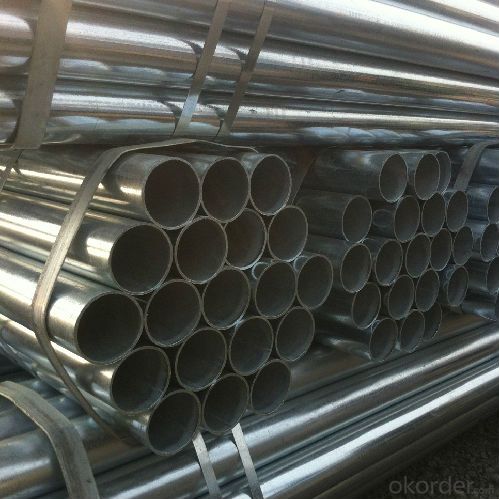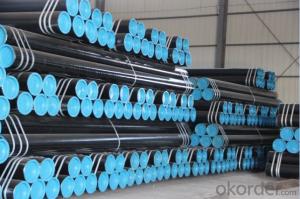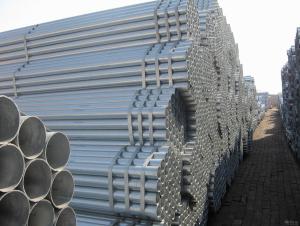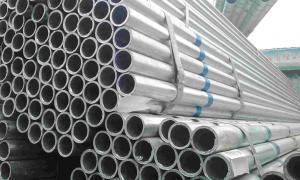Hot Dipped or Pre-galvanized Galvanized Pipe America Standard A53 Q195
- Loading Port:
- Tianjin
- Payment Terms:
- TT or LC
- Min Order Qty:
- 45 m.t.
- Supply Capability:
- 8000 m.t./month
OKorder Service Pledge
OKorder Financial Service
You Might Also Like
1、Structure of Hot Dipped or Pre-galvanized Galvanized Pipe America Standard A53 Q195 Pre-galvanized Pipe:
The surface of Hot Dipped or Pre-galvanized Galvanized Pipe America Standard A53 Q195 100g Hot Dipped or Pre-galvanized Pipecan increase the corrosion resistance of the steel tube, prolong service life. Galvanized pipe is widely used, in addition to water, gas, oil and other general low pressure fluid pipelines. It is also used in the petroleum industry, especially for offshore oil field of oil well pipe and oil pipe, chemical, coking equipment of oil heater, condensation cooler, coal run oil exchanger tube, and trestle pile, the mine tunnel support frame tube.
2、Main Features of Hot Dipped or Pre-galvanized Galvanized Pipe America Standard A53 Q195 Pre-galvanized Pipe:
• High manufacturing accuracy with standard
• High strength and stable
• Good visual effect
• Reasonable price
• Small inertia resistance
• Strong heat dissipation ability
3、Hot Dipped or Pre-galvanized Galvanized Pipe America Standard A53 Q195 100g Hot Dipped or Pre-galvanized Pipe Specification:
Standard | GB, DIN, ASTM ASTM A106-2006, ASTM A53-2007 |
Grade | 10#-45#, 16Mn 10#, 20#, 45#, 16Mn |
Thickness | 1 - 33 mm |
Section Shape | Round |
Outer Diameter | 21 - 610mm |
Place of Origin | Tianjin, China (Mainland) |
Secondary Or Not | Non-secondary |
Application | Hydraulic Pipe |
Technique | Cold Drawn |
Certification | API |
Surface Treatment | factory state or painted black |
Special Pipe | API Pipe |
Alloy Or Not | Non-alloy |
Length | 5-12M |
Outer Diameter | 21.3-610mm |
Grade | 20#, 45#, Q345, API J55, API K55, API L80, API N80, API P110, A53B |
Standard | ASME, ASTM |
1) Material:20#(ASTM A 106/A53 GRB.API5LGRB,GB),45#,16Mn,10#.
2) Specification range:OD:21.3-610mm,WT:6-70mm,length:6-12m or according to the requirement of clients.
3) Excutive standards:GB,ASME API5L.ASTM A 106/A53,Despite of the above standards,we can also supply seamless steel pipe with standard of DIN,JIS,and so on,and also develop new products according to the requirements of our clients!
4) Surface:black lacquered,varnish coating or galvanized.
5) Ends:Beveled or square cut,plastic capped,painted.
6) Packing:bundles wrapped with strong steel strip,seaworthy packing.
4、Packaging & Delivery
Packaging Details: | seaworthy package,bundles wrapped with strong steel strip |
Delivery Detail: | 15-30days after received 30%TT |
5、FAQ of Hot Dipped or Pre-galvanized Galvanized Pipe America Standard A53 Q195 100g Hot Dipped or Pre-galvanized Pipe:
①How is the quality of your products?
Our products are manufactured strictly according to national and internaional standard, and we take a test
on every pipe before delivered out. If you want see our quality certifications and all kinds of testing report, please just ask us for it.
Guaranteed: If products’ quality don’t accord to discription as we give or the promise before you place order, we promise 100% refund.
②How about price?
Yes, we are factory and be able to give you lowest price below market one, and we have a policy that “ for saving time and absolutely honest business attitude, we quote as lowest as possible for any customer, and discount can be given according to quantity”,if you like bargain and factory price is not low enough as you think, just don’t waste your time.Please trust the quotation we would give you, it is professional one.
6、 Hot Dipped or Pre-galvanized Galvanized Pipe America Standard A53 Q195 100g Hot Dipped or Pre-galvanized Pipe: Images:


- Q: How do you calculate the pipe volume for steel pipes?
- In order to determine the volume of a steel pipe, one must possess knowledge regarding its length and the inner diameter. The formula for calculating the volume of a cylindrical shape, such as a pipe, is V = πr^2h, where V denotes the volume, π represents a mathematical constant which is approximately equivalent to 3.14159, r signifies the radius of the pipe (which is half of the inner diameter), and h stands for the length of the pipe. Initially, employ a measuring tape or a caliper to measure the inner diameter of the pipe. Proceed to divide this value by 2 in order to obtain the radius. Afterwards, proceed to measure the length of the pipe, utilizing inches, feet, or meters. Ensure that the same unit of measurement is used for both the radius and length. Once the measurements for the radius and length have been ascertained, input them into the formula V = πr^2h. For instance, let us assume that the inner diameter of the steel pipe measures 10 inches and the length amounts to 50 feet. Firstly, divide the inner diameter by 2 to determine the radius: 10 / 2 = 5 inches. Next, convert the length into inches: 50 feet * 12 inches/foot = 600 inches. Subsequently, input the values into the formula: V = 3.14159 * 5^2 * 600. By calculating the volume: V = 3.14159 * 25 * 600 = 47,123.85 cubic inches. Therefore, the volume of the steel pipe is approximately 47,123.85 cubic inches.
- Q: How are steel pipes used in water transportation?
- Steel pipes are commonly used in water transportation due to their durability and strength. They can be used for various purposes, such as carrying water from a source to a treatment plant, distributing water to different areas, and even for sewage systems. Steel pipes are highly resistant to corrosion and can withstand high pressure, making them ideal for long-distance water transportation.
- Q: How are steel pipes coated for protection against external elements?
- Steel pipes are coated for protection against external elements through various methods, such as hot-dip galvanizing, epoxy coating, or fusion-bonded epoxy coating. These coatings provide a barrier between the steel and the environment, preventing corrosion and extending the lifespan of the pipes.
- Q: How are steel pipes recycled?
- Steel pipes are recycled through a multi-step process that involves collection, sorting, cleaning, and melting. First, the used steel pipes are gathered from various sources such as construction sites or industrial facilities. Then, they are sorted based on their size, shape, and quality. Next, any contaminants or coatings are removed from the pipes through cleaning and stripping processes. Finally, the cleaned pipes are melted down in a furnace, and the molten steel is formed into new pipes or other steel products. This recycling process reduces the demand for new raw materials and helps conserve energy and resources.
- Q: Can steel pipes be used for water distribution networks?
- Yes, steel pipes can be used for water distribution networks. Steel pipes are commonly used for water distribution due to their durability, strength, and resistance to corrosion. They can handle high pressure and are able to withstand extreme weather conditions, making them suitable for long-term use in water distribution networks.
- Q: How are steel pipes used in wastewater treatment plants?
- Steel pipes are used in wastewater treatment plants for various purposes such as transporting wastewater, carrying chemicals and additives, and supporting the infrastructure.
- Q: Can steel pipes be used for underground sewage systems?
- Yes, steel pipes can be used for underground sewage systems. Steel pipes have high strength and durability, making them suitable for carrying sewage and withstanding the pressure and environmental conditions underground. Additionally, steel pipes have excellent corrosion resistance properties, which is crucial for sewage systems that are exposed to moisture and various chemicals.
- Q: How to distinguish seamless pipe and welded pipe?
- Most of the welded pipe is six meters, the pipe has obvious welding marks, and seamless pipe wall without welding marks
- Q: Can steel pipes be used for conveying abrasive slurries?
- Yes, steel pipes can be used for conveying abrasive slurries. Steel pipes are known for their durability and strength, making them suitable for handling abrasive materials. Additionally, their smooth interior surface reduces friction and minimizes the risk of clogs or blockages caused by the abrasive particles present in slurries.
- Q: What are the different methods of lining steel pipes?
- There exist various techniques for lining steel pipes, each possessing distinct advantages and applications. Some popular methods comprise: 1. Cement Mortar Lining: This technique entails the application of a cement mortar layer onto the inner surface of the steel pipe. Cement mortar offers outstanding protection against corrosion and grants smoothness to the pipe, consequently diminishing friction and enhancing flow rates. It finds common usage in water supply systems and sewage treatment plants. 2. Polyethylene (PE) Lining: PE lining necessitates the insertion of a polyethylene tube into the steel pipe. Typically, the tube is heat fused or mechanically connected to the steel pipe, resulting in a seamless and corrosion-resistant lining. PE lining is commonly employed in gas transmission and distribution pipelines. 3. Epoxy Lining: Epoxy lining involves the application of an epoxy resin onto the inner surface of the steel pipe. Epoxy coatings exhibit exceptional resistance to corrosion, abrasion, and chemicals, thereby making them suitable for a variety of applications such as oil and gas pipelines, water treatment, and industrial processes. 4. Trenchless Pipe Lining: This method serves to rehabilitate existing steel pipes without the requirement of excavation. It encompasses the insertion of a liner or resin-coated fabric into the existing pipe, which is subsequently inflated and cured to form a new lining. Trenchless pipe lining is commonly utilized for sewer and water main rehabilitation. 5. Polyurethane (PU) Lining: PU lining involves the spraying or pouring of a polyurethane coating onto the inner surface of the steel pipe. Polyurethane linings deliver excellent resistance to abrasion, impact, and chemicals, thereby suiting applications in mining, slurry pipelines, and wastewater treatment. These represent merely a few of the numerous methods accessible for lining steel pipes. The selection of a lining approach is contingent upon factors such as the intended application, the environment, and the desired level of corrosion resistance and durability.
Send your message to us
Hot Dipped or Pre-galvanized Galvanized Pipe America Standard A53 Q195
- Loading Port:
- Tianjin
- Payment Terms:
- TT or LC
- Min Order Qty:
- 45 m.t.
- Supply Capability:
- 8000 m.t./month
OKorder Service Pledge
OKorder Financial Service
Similar products
Hot products
Hot Searches
Related keywords


























